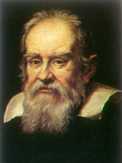Tests of the Heliocentric Model
- Tycho Brahe (1546 - 1601), a Danish nobleman, was renowned for his development of astronomical instruments and his use of them to make measurements of the positions of stars and planets.
His data were the most accurate available prior to the introduction of the telescope into astronomy, shortly after his death.
Amongst other discoveries, he made accurate measurements of a supernova in 1572, and showed that it was in the realm of the stars, which was believed to be unchanging.
- Tycho noted that the Copernican model predicts that stars should appear to shift their position as the Earth moves around the Sun, due to parallax:

Tycho attempted to measure this parallax, but he was unable to do so, and therefore concluded that the premise that the Earth moves around the Sun was wrong.
Actually, it was Tycho's confidence in his own measurements which was ill-founded!
As we have already seen, the stars do exhibit parallax, but because they are so far away, a telescope is required to observe it!
However, this is still a good example of the scientific method in action: a prediction is made, and then tested by subsequent observations.
- The telescope was invented by a Dutch optician late in the 16th century.
Galileo Galilei (1561-1642), a professor of mathematics at the University of Padua, heard about the telescope in 1609.
Recognizing the telescope's possibilities, Galileo immediately built one of his own, based only the sketchy details he had heard.
Galileo then improved the design of the telescope to the point where it could be used for astronomy.
Galileo quickly made several important astronomical discoveries, which were published in 1610 in his book The Starry Messenger.
- One of Galileo's observations was that Venus exhibited phases similar to the Moon's:

Galileo noticed that Venus' phases were related to its angular diameter andelongation: it is smaller (farther away from us) at the gibbous phase and larger (closer to us) at the crescent phase, with the extremes occurring at small elongations.
These observations were strong confirmations of the heliocentric model.

- Galileo also saw the four large moons of Jupiter, now called the Galilean satellites.
The Galilean satellites were obviously orbiting Jupiter, which was contrary to a basic assumption of the geocentric model, viz. everything in the heavens orbited the Earth.
- In 1616, when Copernicus' book was banned, Galileo was instructed by the Vatican that he could only discuss the heliocentric model as a "mathematical supposition" because anything else would "restrict God's omnipotence".
Nevertheless, in 1632 Galileo published Dialogue Concerning the Two Chief World Systems--Ptolemaic and Copernican, which was such a masterpiece of exposition of the heliocentric model that readers ignored the ordained conclusion.
Galileo was then brought before the Inquisition and forced to publicly recant; hisDialogue was banned, and he spent the last eight years of his life under house arrest.
The ban on Galileo's Dialogue wasn't lifted until 1822, and the Vatican's censure of Galileo himself wasn't removed until 1992!
Extra: you can find out much more about Galileo at PBS/Nova's website,Galileo's Battle for the Heavens.




No comments:
Post a Comment